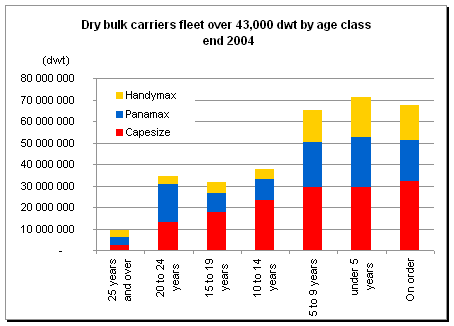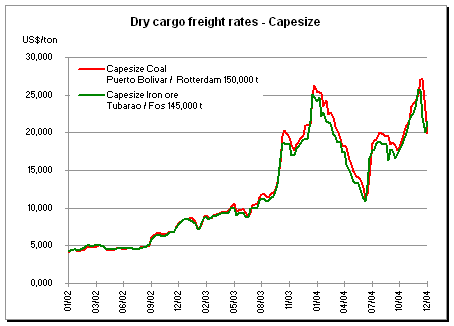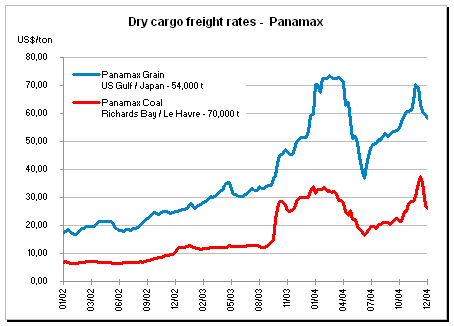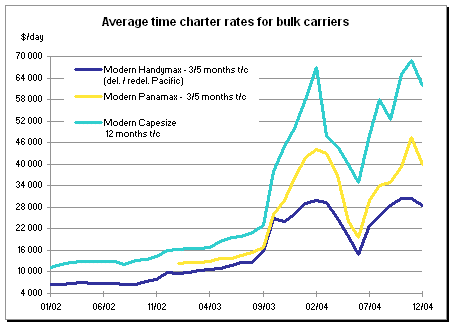
|
The dry bulk
market in 2004
|
The dry bulk market
The second-hand market:
Capesize - Panamax
- Handymax & Handysize
|
|
Together with all the other sectors of the
shipping market, 2004 was an exceptional year in
the dry bulk. On the back of a very strong surge
at the end of 2003, rates peaked in March before
taking a plunge until the end of June. Then, they
rebounded until December to reach and sometimes
surpass previously established records. One only
has to look at the figures of the following daily
returns: $ 35,000 per day for a Handymax, $ 50,000
per day for a Panamax, and over $ 100,000 per day
for a Capesize.
World demand for industrial dry bulk
commodities increased sharply and exerted a strong
pressure on charterers. All raw materials were
affected. Demand took off, notably in the coal and
ore sectors, which represent over half of the
total volumes. Tonnage transported for iron ore
went from roughly 520 million tons in 2003 to
about 570 million tons in 2004. Coking coal
increased from about 185 million tons to nearly
200 million and steam coal from over 420 million
tons to 440, an overall rise of 7 %.
Depending on sources, the growth in
volume in 2005 is expected to be around 5.5 to 6
%. Such figures make people fill dizzy and cannot
be compared with what was experienced during the
last fifteen years where we usually saw an average
growth of 2 to 4 % depending on the years.
There is one key player who emerges
from any analysis of the market: namely China.
Having shown its potential over recent years, the
rise in strength of the country has never been as
clearly defined as in 2004.
The press has largely been following
and reporting this phenomenon. Carried along by
strong growth, Chinese demand for steel grew by
more than 13 % in 2004 over the year. According to
the Chinese Association for Ore and Steel (CSIA),
domestic production went from 225 million tons in
2003 to 270 in 2004, with the aim of reaching 300
million tons in 2005.
At the same time, imports of iron ore
went from 110 million tons in 2002 to nearly 200
million tons in 2004 (of which 80 million tons
originating from Australia and from Brazil). As a
result, there was heavy congestion in loading and
discharging ports at the beginning of the year,
which inevitably affected the global supply of
available tonnage. This situation improved as from
March when the Chinese authorities became aware of
the extent of the problem and decided to implement
de-stocking measures in the ports. Once begun,
freight rates started to drop significantly.
During the month of June demand took
off again, thus indicating that the efforts by the
Chinese government to slow down economic growth
were insufficient, precipitating another sharp
rise in rates. Swept along by the dynamics of the
market and the anticipation of high freight
levels, this in turn provoked a surge in
time-charter activity.
At the same time, operators became
actively engaged on the freight futures market.
Encouraged by the volatility of the physical
market, a number of players found an answer to
their needs of getting forward cover with
derivatives. In many respects, it could be said
that 2004 paved the way towards a maturing of
these markets. It is worth noting that their
influence in the decision making process for both
owners and charterers, especially on contracts of
affreightment and period charters, is growing.
Simultaneously, and also to reduce
their exposure to an increasing volatility of the
market, the main charterers and owners have been
putting an emphasis on concluding long term
partnerships, giving a long term business flow to
the latter and a guarantee of regularity and
stability in supply costs to the former.
However in this euphoric context,
there are some signs that suggest a certain
caution, starting with the rising supply of
tonnage.
|
|
|
Ingrid Oldendorff
75,000 dwt, built in 2005 by Jiangnan, operated
by Oldendorff Carriers
|
|
Numerous orders placed in 2003 and
2004 will start to be handed over to the market in
2005 and 2006. This historically high level of
deliveries combined with a virtually non-existent
volume of demolition should eventually start to
have consequences on the market balance during the
next few years.
Thus for Capesize, 8 million dwt were
delivered in 2004, 8.7 are due in 2005 and 9.5 in
2006. For Panamax, 6 million dwt were delivered in
2004, and in 2005 the figure should be 6.8 million
dwt. And for the Handymax, after 4.5 million dwt
added in 2004, 6.2 million dwt can be expected in
2005!
|
|

|
|
Some factors could act in the favour of reducing the
pace of delivery, for instance, the first being the
price of steel and the difficulties shipyards have in
buying engines. There is a high probability that we
shall see numerous delays in deliveries. On the demand
side, the slightest change in the economic policy of
the Chinese government, with implications on imports
and exports, will be measured in the light of the
strategic role played by China today on the
international scene. Based on CISA forecasts, the level
of ore imports should reach 240 million tons in 2005,
an increase of around 20 % compared to the 40 %
witnessed in 2004.
Finally, a serious question mark remains
as to the capacity of the main Australian and Brazilian
ports to be able to handle the increase in demand as,
at the same time, their productivity seems to be unable
to improve in the short term. If this congestion
phenomenon lasts, this will prevent a further growth of
the trade flow and consequently new tonnage that will
be introduced on the market would generate a surplus.
Some old ships could then find their way to the
scrapyards.
2004 will therefore be classified as an
outstanding vintage, a historic year that is only seen
once in a lifetime. This year has signalled the break
with the long decades of cheap or even undervalued
transport. The importance that China has acquired in
world trade and her appetite for raw materials, has
been and will remain the determining factor within the
market evolution. The imbalance between supply and
demand has led freight rates to levels never achieved
before.
However, one should not underestimate the
impact that the massive deliveries of new ships will
have and although it is difficult to measure precisely,
it will logically push owners to sell some older ships
for scrap. In addition, even if demand is strong, the
logistical difficulties encountered either with the
distribution network or with port infrastructures, as
well as a possible slowing down of China's imports,
could cast a shadow on the market.
|



|
|
The second-hand
market |
|
|
|
|
The second-hand market for Capesize
(80,000 dwt and more) 2003 |
|
|
Unbelievable!
Swallowed up like so many others by the
ferocious appetite of China for raw materials,
freight rates took off to levels that nobody would have
imagined and even less hoped for. The scarcity of
berths for newbuildings helped feed this frenzy to
purchase second-hand ships or newbuilding contracts
with prompt delivery, the latter being able to be
quickly repaid given the rates they can obtain on the
market.
When in December 2003, a 5 years old
170,000 dwt ship, built in a good shipyard was worth
about $ 48 to 49 million, its value was close to $ 62
million in March 2004!
At the end of June or early July, after a
rather severe correction in the market, brought about
by statements from the Chinese Prime Minister
concerning necessary measures which were needed to slow
down the economy that had become overheated, this same
type of ship saw its value drop back to a level of
around $ 45 million.
However the market did not cool off for
long and the year ended with prices rising again to $
65 to 66 million.
We have been able to record some fifty
transactions in the course of this extremely active
year.
It is surprising to see that the rise in
values has affected all ships irrespective of age and
that a number of new buyers have emerged, principally
Chinese, for whom purchasing has rapidly become an
alternative to chartering at prohibitive rates.
In order to stay in the competition, some
transactions have often been made without any
inspection being carried out on the ship.
At the end of the year a distinct bullish
trend was still clearly perceptible.
|
|
|
Eric LD
169,900 dwt, built in 1999 by Daewoo HI, sold
at the end of the year by Louis Dreyfus Armateurs
to Diana Shipping Agencies
|
|
The Panamax, Handymax & Handy bulk
carrier second-hand market |
|
|
For all of us in shipping, 2004 will be the year we
shall remember for a very long time. We thought that
2003 was THE year but 2004 surpassed all expectations.
We had concluded last year's review by stating: 'If the
world economic data and indicators available can be
considered as reliable then we would expect the dry
bulk freight market to remain at levels considered as
very firm and we would not therefore expect bulk
carrier prices to ease off any time soon. In fact we
would expect prices to firm further, so, for those
contemplating an investment in dry bulk tonnage the
sooner this is undertaken the better it will be' and we
added 'Today's extremely firm price becomes tomorrow's
normal market price and a few weeks later it is
considered as cheap'.
This was exactly what happened and even
more, much more '
Prices for second-hand tonnage followed
the freight market increases without a miss. On some
occasions the increase in values was much more
important than the equivalent freight rate increase, as
buyers and sellers alike were anticipating further
increases.
Comparing second-hand values, for the
various sizes under consideration, at the end of 2004
against those at the end of 2003 we've noted:
an average of 45 % to 65 % increase in the
Panamax size, an average of 50 % to 60 % increase in
the Handymax size, an average of 40 % to 50 % increase
in the Handy size.
Demolition sales remained at an all time
low and of course prices achieved by dry bulk tonnage
sold for demolition remained extremely high. They moved
from $ 270-275 per ldt at the end of 2003 to the
'astronomical' levels of $ 370-380 for vessels sold for
demolition to India, whereas the Chinese were paying
about $ 320 per ldt at the end of 2004 compared to
about $ 290 about 12 months earlier.
2004 was the year of the large 'en-bloc'
deals, it was also the year when traditional tanker
owners diversified in the dry bulk sector, the year
during which a 15 to 20 year-old bulk unit was worth
more than ever before, prompting several owners (e.g.
Oceanbulk Maritime) to sell a large number of such
vintage ladies and at last the year of some successful
Initial Public Offerings (IPO's) shipping companies
(mostly Greek controlled) managing and involved in dry
bulk vessels, in the U.S. public equity markets.
Among these 'en-bloc' transactions it is
worth noting:
-
The Restis group acquisition for $ 740
million of the whole MISC dry bulk fleet consisting of
32 bulk carriers (9 Panamaxes, 9 Handymaxes and 14
Handies)
-
The General Maritime Group (Peter
Georgiopoulos), acquisition for $ 420 million of the
Top Glory fleet consisting of 16 bulk carriers (5
Panamaxes, 6 Handymaxes and 5 Handies)
-
Precious Shipping concluded a number of
en-bloc acquisitions in the Handysize segment (all
mid/early 1980's built): 9 Handies from PNSL (Malaysia)
in March, 6 Handies from Pacific Basin in February and
in addition, there were linked to another 10 to 12
purchases of Handies over the year.
Some of the traditional tanker owners have
been actively participating in the dry bulk carriers
second-hand market, like General Maritime (mentioned
earlier), Frontline (John Fredriksen), and others.
|
|
Ship's values evolution
At the end of the year a 10 year-old
Panamax bulk carrier was worth about $ 32 to 33
million, representing an increase of about 65 % over
the past 12 months, a 5 year-old Panamax bulk carrier
was worth about $ 40 million, which represents about 48
% appreciation when compared to the value recorded one
year earlier.
A 10 year-old Handymax bulk carrier was
worth about $ 25 million, representing an increase of
about 55 % over a period of 12 months, a 5 year-old
Handymax bulk carrier was worth about $ 31 million,
which represents a 55 % appreciation when compared to
the same period one year earlier in December 2003.
A 10 years old Handy bulk carrier was
worth about $ 16 million, representing an increase of
about 45 % over a period of 12 months, a 5 years old
Handy bulk carrier was worth about $ 21.5 million,
which represents a 48 % appreciation when compared to
how much it was worth one year earlier in December
2003.
|
|
Prospects
Concluding this year's review of the
second-hand dry bulk carrier markets, the eternal and
unavoidable question is still on everyone's mind 'How
long will this freight market and consequently the
second-hand market last?' There is no clear answer and
as always all involved in shipping will be trying to
analyse the world economic data, the supply and demand
situation which is fundamental in all markets, but,
more importantly, everybody will be looking closely to
the Chinese economy and the availability or rather the
non-availability of building berths for dry bulk
carriers (in the sizes we have been referring to).
We may therefore witness the second-hand
prices for Panamax, Handymax and Handy bulkers behaving
in a much more volatile style than during the past 12
to 24 months and as such any investment in this sector
should be pursued cautiously. The other face of the
coin, would of course be to capitalise on the present
very high values and sell any tonnage, purchased at much
lower levels.
|
Shipping and Shipbuilding Markets in 2004
I N D E X
|